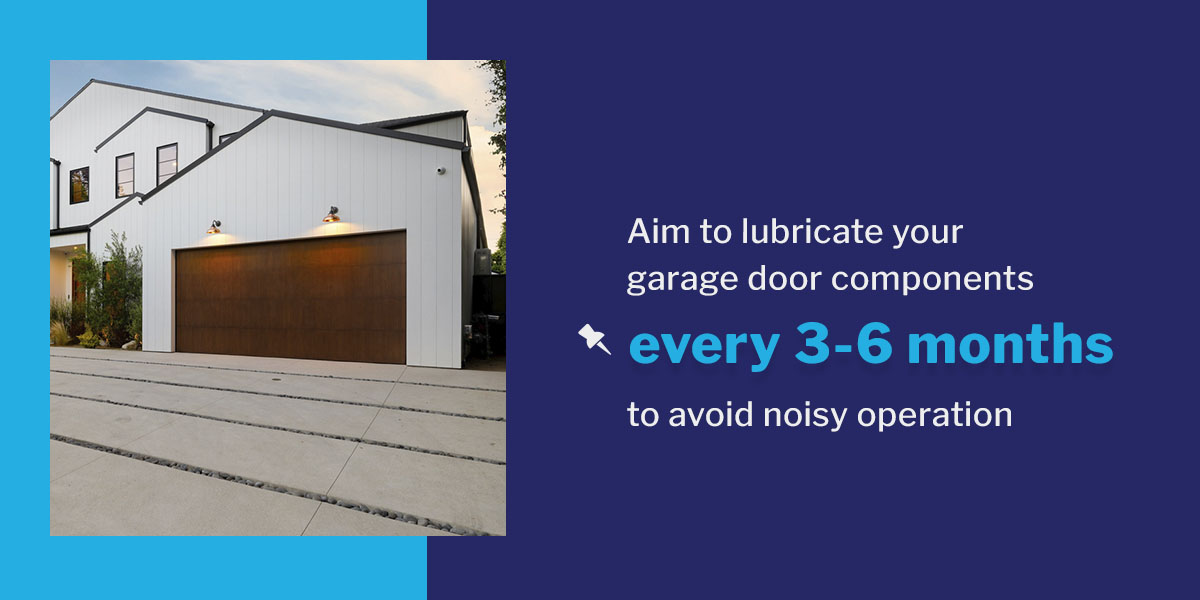If your garage door is noisy when it opens and closes, it probably needs lubricating. You may feel tempted to buy the first lubrication you see and spray all the parts. However, not all lubrication is good for the components, and all the parts don’t need spraying.
Discover which lubrication is best, which components to lubricate and how often you should lubricate your garage door.
Before you lubricate your garage door, it helps to know what you’ll need and what to avoid. Being prepared can save you time during the process, and you’ll be familiar with the do’s and don’ts. Keep the following in mind:

Aim to lubricate your garage door components every three to six months to avoid noisy operation. If you use your garage door frequently, three months is best, but for average use, six months will help ensure the components remain lubricated. Regardless of this time frame, you can lubricate your garage door if you notice the following:
Now that you’re ready, you can begin spraying your garage door parts. Make sure you get a sturdy, safe ladder and a working cloth. Also, try to start with the parts that are highest up to save time and prevent any dust from falling onto the newly wiped components below, like on the hinges.
Clean the tracks by wiping them down with a wet cloth. Use mild soap and water or vacuum the area with the hose attachment for stubborn dirt, then wipe any product off thoroughly. You won’t be lubricating the tracks, but cleaning any debris will help the rollers operate smoothly.
If there’s time, you can also clean some other components to ensure no small objects or dirt could interfere with the lubrication’s performance.
If you’re unfamiliar with where it is, you’ll find your garage door rail above the door, usually in the middle and close to the ceiling. Some types of garage doors don’t have it, but if yours does, you’ll need to get on a ladder to lubricate the rail. You only need to lubricate it on top where the chain rides during operation. Spray some lubrication on top of the rail and distribute it with the cloth.
Use the lubrication sparingly, and don’t lubricate the chain or the bottom of the rail. Belt drive systems don’t need lubrication, so consult a professional if you’re unsure.
The armbar is also at the top of your garage door. Position the hose attachment on the lubrication spray bottle close to the bolts and folds of the arm, and spray once or twice. Locate your garage door’s lock and spray this as well, paying close attention to the keyhole.
The springs are crucial to the operation of your garage door, and lubricating them regularly protects their integrity. They’re found at the top of your garage door close to the wall, and you’ll also need a ladder. Spray the outside of the springs and the bearing plates next to them. Focus on the center of the bearing plates, as this part helps the garage door move.
It’s a good idea to open and then close your garage door again to help spread the lubrication.
The rollers are next to the hinges of your garage door. When lubricating them, focus on the small ball bearings inside them, not the actual wheels. These bearings help your garage door move and, when lubricated, allow it to open and close quietly. If you have nylon rollers, avoid lubrication. You can also switch to nylon rollers if lubricating your current rollers doesn’t work.
Hinges connect the garage door panels and facilitate the opening and closing of the door. While lubricating the hinges, remember that it’s best to incrementally open your garage door manually as you lubricate. Using the thin hose of the lubricant bottle, spray each hinge as it bends while you’re opening the garage door. Pay attention to the moving parts, as doing so will make the door much easier to operate.
When lubricating moving parts, having the best garage door lubricant, like silicone-based products, and knowing which parts to lubricate can protect the components. There’s less friction and stress, and the door moves more easily.
Viking Overhead understands your garage door is an important investment. We have years of experience and can diagnose any issue, from minor glitches to major breakdowns. Whether you’re dealing with noisy operation, a door that keeps getting stuck or any other inconvenience, we can assist. Call us for a chat, or contact us online to send your message or book a service.